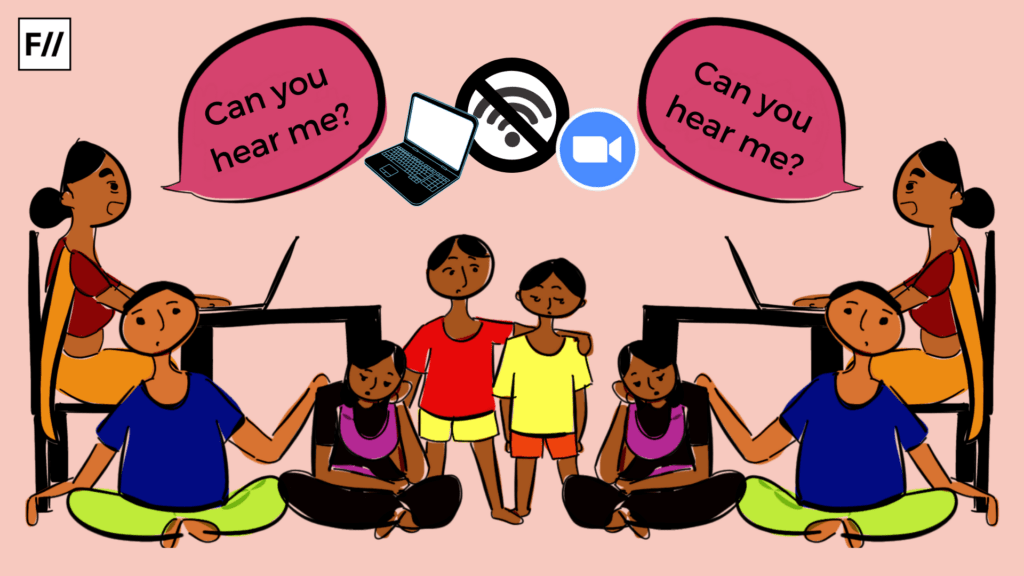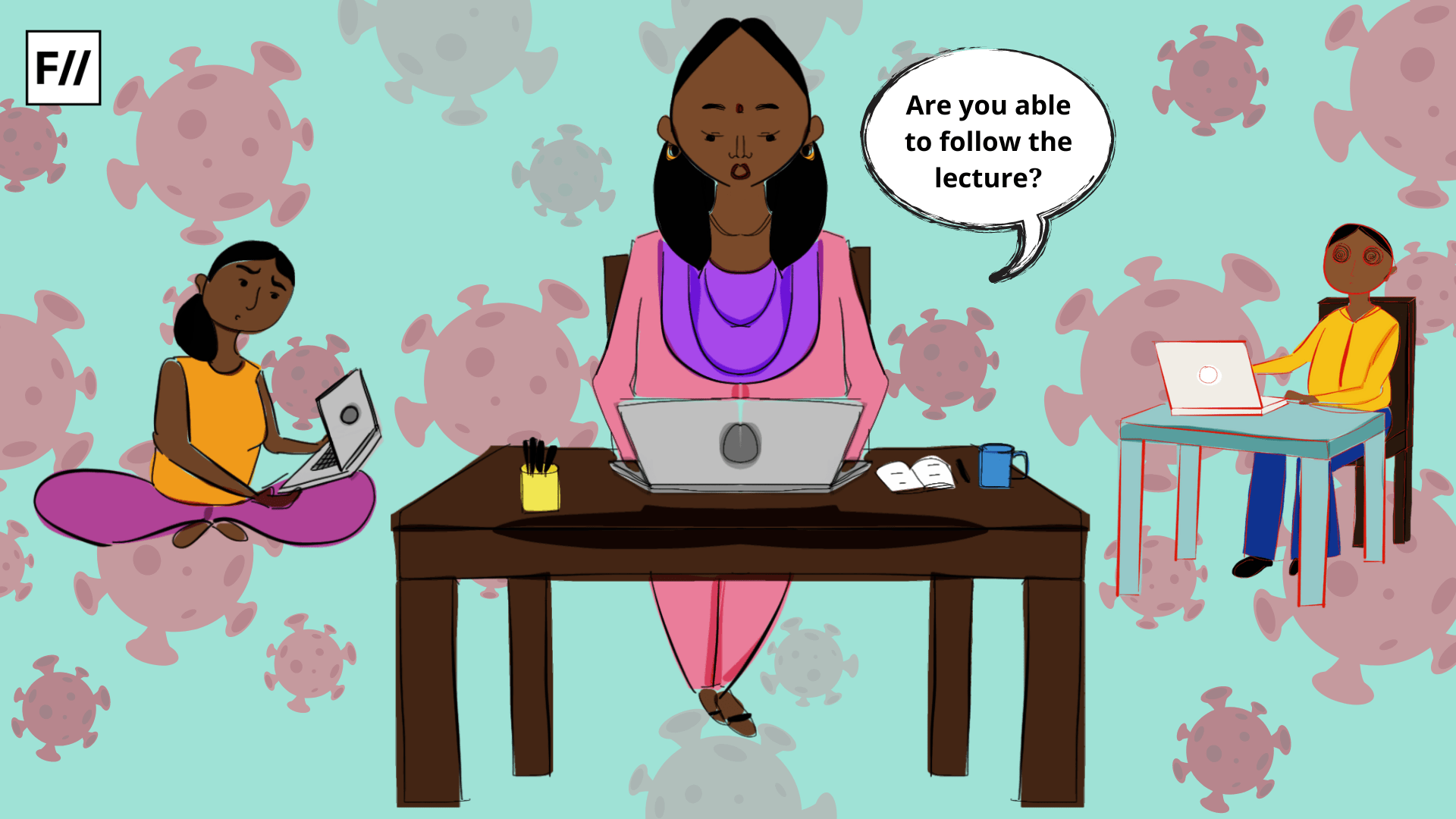Editor’s Note: FII’s #MoodOfTheMonth for August, 2021 is Digital Realities. We invite submissions on the many layers of experiences from the virtual world throughout the month. If you’d like to contribute, kindly email your articles to sukanya@feminisminindia.com
As with many industries, COVID-19 has disrupted the tertiary education sector in many ways – loss of students and their fee contributions, rapid transformation of the structured university learning environment, increased stress and isolation for students and staff, and the very sudden shift to online course delivery.
The switch to digital teaching in early 2020 was a survival mechanism, meant to keep students, faculties, both teaching and non-teaching staff, safe. This meant not only shifting to online course delivery but also digitalisation of teaching materials, which is not specifically a consequence of the pandemic, but its objective was to make knowledge accessible and available online through the collaboration of teachers and IT professionals.
The goal perhaps was the continuation of knowledge as a service provision but critical academics began to pause and reflect on what new structures were being built and how we envision a digital pedagogy in the foreseeable futures. With advancing physical and mental health impacts of burgeoning screen time for students, families and teachers alike, there are larger questions about surveillance and privacy which are debated, discussed and eventually relegated to the backburner.

The impact on student participation and peer-to-peer learning
Most Indian universities relaxed attendance rules and put in place COVID-19 protocols for teaching and research. Universities also conducted surveys and discussions with students, as well as parents, to allay fears and ambiguities about the digital mode of teaching for the approaching semesters.
As a discipline, environment studies, draws from global expertise and insights on themes like ecologies, cultures, histories, geographies, theories, practices and policies, as well as the understanding of contexts and communities, over time and place. As a student, I had benefitted hugely from the rich learning environment that was enabled through peer to peer and student led learning.
As a teacher though, I found it difficult to replicate this in digital settings. How can one facilitate peer to peer interactions anchored on group work and critical discussion of reading materials when we do not have even our cameras turned on? Those with language barriers faced further difficulties in conversing online compared to conversing face-to-face, in small groups
I became critical of theories and practices because my peers positioned themselves as such. Reflexively, I developed my ideas through peer learning, group discussions and consultations, mainly because these activities encouraged self-reflexivity and constructive, critical approaches through listening, while also clearly articulating my own ideas and opinions.

As a teacher though, I found it difficult to replicate this in digital settings. How can one facilitate peer to peer interactions anchored on group work and critical discussion of reading materials when we do not have even our cameras turned on? Those with language barriers faced further difficulties in conversing online compared to conversing face-to-face, in small groups.
Also read: Digital Learning: Covid Underlines Privilege Divide And Inadequate Teacher Training
Online debates on synchronous and asynchronous teaching list out the pros and cons but for majority Indian universities, the task was to replicate face to face teaching using digital methods. The onerous task of reworking practice-based and experiential modules which require extensive changes, fell on lecturers and teachers with minimal support.

While this was the case with lecturers, students, who were expected to replicate their offline participation in an online world had to turn up and do it with slow internet, surrounded by young children or other family members.
They had to navigate the problems of living in shared accommodations, mostly with sub-optimal IT facilities. Some had to work off their telephones and some without proper microphone or video facilities.
Gender, mental health and digital teaching
Although teaching in higher education institutes is lucrative, especially for a female teacher like me, I doubt how much flexibility, and freedom I really have. I reflected upon my personal responsibilities of childcare and home-schooling during the pandemic.
“How are you doing? What’s the one thing that’s keeping you sane in these times?”
Of the three semesters I have taught, 90 per cent of my lectures began with these questions. More than being a teacher, my unspoken job has been that of a counsellor, while juggling other personal responsibilities of childcare and home-schooling. The fact that I was expected to also be more sensitive and nurturing, something everyone should invariably be, was in this case, also because of my being a woman.
Through the difficult months of the pandemic, I sometimes left my classes unstructured as a way to offer space for students to be themselves with their abandoned reading assignments, tiresome screen time and complicated family and home arrangements. Some students were in the practice of sharing computers and tablets with their siblings and timed their online classes accordingly.
Critical and reflexive teachers who question the balance between longer lectures and shorter tutorials, re-evaluate the structure of learning, attempt to build trust and solidarity online without ever having met each other, and provide a safe space to each and every student so that they feel heard and seen, are resisting the neoliberal capitalist approaches towards the commodification of education
While online education provides an opportunity to engage with students far and wide, and learn from global experts who are invited as speakers virtually, the significance of peer to peer learning model remains underexplored while teaching digitally. Regularly checking with students on how courses are structured, designed, delivered and assessing what worked for them and what did not, has to inform courses taught in subjects like environmental studies.

During my lectures, I tried to indulge the students in creating digital doodles on some days, while watching films instead of lectures and seminars on others. We pause and observed nature around us and shared our reflections in class.
In the absence of eye-contact and other crucial non-verbal communication cues, students’ feedback is often relegated to and flattened along the side chat box. How do I engage my students if I cannot notice their shifts in attention? How do I offer them reassurance, probe their understanding through questioning and encourage collaboration without actually witnessing them paying attention?
Also read: Learning Through Rectangles: Online Classes Have Taken Away Some Precious Moments From Us
The proverbial raising hands is now limited to a mere icon on my screen and the silences after posing a question is deafening as I see nothing flickering on my screen.
What does this mean for the future?
COVID-19 has offered numerous learning opportunities, while also imposing significant constraints. Some students were forced to drop classes, while many other students struggled because they or their family members were suffering health wise. Students are already taking on the above stressors alongside the requirements for assessment, examinations and submissions.
This cumulatively exerts great pressure on them to not just perform well, but also excel, so that further career and learning opportunities are not deterred due to the disruption caused by the pandemic.

Critical and reflexive teachers who question the balance between longer lectures and shorter tutorials, re-evaluate the structure of learning, attempt to build trust and solidarity online without ever having met each other, and provide a safe space to each and every student so that they feel heard and seen, are resisting the neoliberal capitalist approaches towards the commodification of education.
The least we can expect universities is to not overlook these fundamental issues by brushing them under the carpet. We owe this to the teachers and students who are trying their best to cope, as well as those to come.
Featured Image: Ritika Banerjee for Feminism In India
About the author(s)
Dr. Sneha Krishnan is trained to be a researcher in the interstices of development, health and disasters. One day she grew tired of the world of research that converted people’s life stories into data and evidence, and instead dived deep into the world of telling stories with prose, poetry and photographs. Her poetry, essays and stories have been published in The Conversation, Helter Skelter, Belongg, Medium and The Wire. She also organises the Indian Film Festival of Bhubaneswar (IFFB) and Indian Documentary Film Festival of Bhubaneswar (IDFFB). She has a PhD in Environment Engineering from University College London and Professor of Environmental Studies at Jindal Global University. She can be found on Facebook, Twitter, Instagram and LinkedIn.




